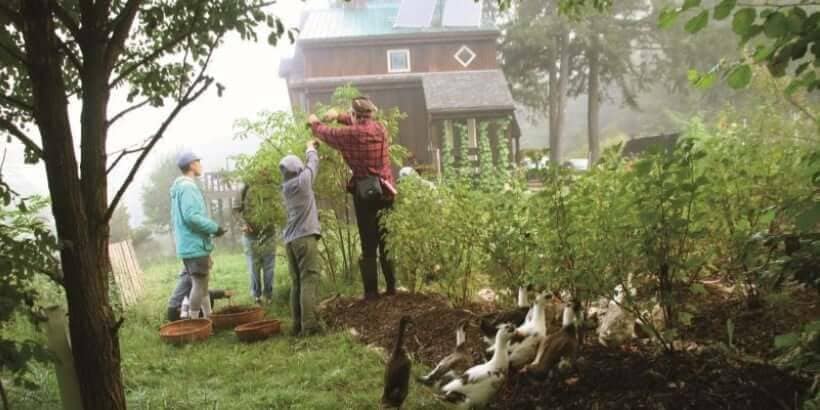Resilient Living: 12 Must Have Books

Are you looking to grow and prepare your own food, conserve energy, and be more resilient? Maybe you’re looking for ways to simplify your life. Wherever you find yourself, there are things you can do today to become more resilient. We’ve compiled our favorite books about all aspects of resilient living to get you started.
Typical books about preserving garden produce nearly always assume that modern “kitchen gardeners” will boil or freeze their vegetables and fruits. Yet here is a book that goes back to the future—celebrating traditional but little-known French techniques for storing and preserving edibles in ways that maximize flavor and nutrition.
Preserving Food Without Freezing or Canning offers more than 250 easy and enjoyable recipes featuring locally grown and minimally refined ingredients. It is an essential guide for those who seek healthy food for a healthy world.
Featured Excerpts:
Four Ways to Preserve Your Green Bean Bounty
How to Preserve Food Without Nutrient Loss
|
|
|---|
2018 James Beard Foundation Book Award Finalist

Mastering Stocks and Broths is the comprehensive guide to culinary stocks and broths that passionate home cooks and innovative chefs have all been waiting for.
Featured Excerpts:
The Fundamentals of Stocks and Broths
A Good Stock Takes Time: Setting Up Your Kitchen for Making Stocks and Broths
|
|
|---|

Written by well-known plant breeder and organic seed expert John Navazio, The Organic Seed Grower is the most up-to-date and useful guide to best practices in this exciting and important field.
Featured Excerpts:
Choosing the Right Seed Crop
A Short History of Agricultural Seed
|
|
|---|

Both a conceptual and a hands-on organic gardening book, and is suitable for vegetable gardeners at all levels of experience.
Featured Excerpts:
Food in Uncertain Times: How to Grow and Store the 5 Crops You Need to Survive
How to Plan the Best Garden Ever
|
|
|---|
Both a business guide and a farming manual, The Organic Medicinal Herb Farmer will teach readers how to successfully grow and market organic medicinal Western herbs.
Whether you’re trying to farm medicinal plants, culinary herbs, or at-risk native herbs exclusively or simply add herbal crops to what you’re already growing, successful small-scale herb farmers Jeff and Melanie Carpenter will guide you through the entire process—from cultivation to creating value-added products.
Featured Excerpts:
Why Grow Medicinal Herbs?
|
|
|---|
Since its original publication in 1989, The New Organic Grower has been one of the most important farming books available, with pioneer Eliot Coleman leading the charge in the organic movement in the United States.
A must-have for any agricultural library!
Featured Excerpts:
Garden Planning: 48 of the Most Promising Veggies
Ditch the pots, use soil blocks!
|
|
|---|

Featured Excerpts:
Wild Spicy Forest Paste
How to Make Naturally Fermented Raw Soda
|
|
|---|

Featured Excerpts:
How to Choose the Right Breed for Your Poultry Flock
Manage Your Chicken Manure: The Joys of Deep Litter
|
|
|---|

Featured Excerpts:
Grow Mushrooms on Your Jeans. Seriously.
Drill, Plug, Wax, Wait: Four Easy Steps to Growing Mushrooms Outdoors
|
|
|---|

Featured Excerpts:
Bramble On: The Ins and Outs of Growing Raspberries
The Six Pests Plaguing your Fruit Trees — and How to Control Them Organically
|
|
|---|

Featured Excerpts:
Optimize Your Soil with Cover Cropping
Perennial Power: Why You Need Them in Your Garden
|
|
|---|

In a friendly, almost conversational way, Bonsall imparts a wealth of knowledge drawn from his more than forty years of farming experience. “My goal,” he writes, “is not to feed the world, but to feed myself and let others feed themselves. If we all did that, it might be a good beginning.”
Featured Excerpts:
How to Make Your Own Mulch With Fallen Leaves
|
|
|---|
Recommended Reads
Recent Articles
The Garlic Clove! This small crop adds a big punch of flavor that complements almost every delicious dish you could think of. And the best part? These two recipes are a breeze to make together!
Read MoreOur love affair with amaranth began long before the pseudo-grain became a trendy staple for gluten-free folk. The luscious leaves of this annual plant are not only packed with a plethora of health benefits.
Read MoreAside from the sheer pleasure of telling your friends, straight-faced, that you maintain your garden using something called a “chicken tractor,” there are a slew of other benefits to working the land with a few of your animal friends. Getting rid of pests without chemicals, for one; letting them do the work of weeding and…
Read MoreIf the idea of running a vegetable farm sounds daunting, you’re not alone. What can you do to simplify techniques and reduce expenses? Where do you even begin?
Read MoreDon’t know where to start for foraging wild plants? Read on for the information you need to begin foraging on your own: where to do it and how to be safe.
Read More










